 Visitors and clicks have long been the accepted metrics to quantify the appeal of online content and the cost of digital ads.
Visitors and clicks have long been the accepted metrics to quantify the appeal of online content and the cost of digital ads.
Attention-based metrics may now be gaining traction. At least they’re attracting more attention.
Attention metrics measure how much time viewers spend on the web page. Proponents say that’s a far better measure of whether viewers actually saw and remember advertising or web content. By measuring time spent viewing content, advertisers and content producers can learn the true effectiveness of their campaigns.
Unique views and click-throughs present major disadvantages, according to advocates of attention-based metrics. Advertisers and web publishers don’t know if consumers paid attention to the ad or content. Did the viewers barely look at the page after clicking on the link or did they actually read the content and see the advertisements? For all the publishers and advertisers know, the web surfer may have clicked on the link accidentally.
Dave Coletti, vice president of digital media research and analytics at ESPN, told FrontRow that “Reporting how many times a banner ad was clicked, or how many people visited a website or app once in a month, doesn’t provide any insight into how either content or advertising resonated with the fan.” Attention metrics, also called time-based metrics, overcome those challenges by reporting how long website viewers viewed content, proponents argue.
The New Currency
A panel session at the recent Ad Age Digital Conference focused on “Attention Metrics: Is Time the New Currency?” By measuring viewer attention, marketers can be more effective and publishers can develop better content, said panelist Tony Haile, CEO of Chartbeat.
“Price on that time, and attention becomes a way for marketers to be more effective and for publishers to have engaging content,” Haile said, according to Marketing Land. “The more they can capture in view [time], the more that ad is worth. It’s a sustainable business model going forward.”
According to Coletti of ESPN, engagement metrics are a better way to evaluate the performance of content, and then tie that to the opportunity of users seeing an ad. “Ultimately, we’re in the business of capturing the time and attention of sports fans. Our goal is to reach as many of them as possible, reach them as often as possible, and keep them engaged for as long as we can. We serve our advertising partners by giving them the ability to put their marketing message in front of these engaged fans,” he said. Coletti explained that ESPN has advocated using time-based metrics, such as average minute audience, to better represent the avidity of the site’s users and help advertisers better plan their advertising campaigns.
ESPN has also been working with comScore to beta test the tracking of individuals’ content interactions across multiple devices. By including smartphone and tablet usage, ESPN added 3.2 billion minutes to its computer-only tally and increased ESPN’s monthly reach by 42 percent.
The Cost per Hour Model
The Financial Times, an early adopter of attention metrics, began selling online advertising this summer based on cost per hour (CPH). Instead of paying a fixed rate based on impressions, or cost per thousands (CPM), brands pay a variable rate based on the time readers actually are able to view the ad. FT sells blocks of time and guarantees brands will pay only for ads viewed more than five seconds. Ads seen for five seconds or more on the site show up to 50 percent higher brand recall and familiarity than ads visible for shorter times, according to FT.
Online publishers such as Medium and Upworthy, have also advocated attention-based metrics. Medium has used total time reading, while Upworthy has total attention per day, week or month as measures of overall popularity. Total attention per piece measures how many people see a web page and how long they view it.
Publishers supporting attention metrics probably believe that the metric emphasizes their strengths and ultimately increase advertising revenues. For instance, FT has about 12 million unique visitors a month compared to about 200 million for the Daily Mail. However, as Fortune noted, its readers spend more than three times as long on the site as readers of other media outlets. ESPN, which emphasizes video segments, also likely has longer view times than most online publishers.
If attention metrics gain widespread acceptance, they will likely erode the click-bait tactics that entail sensationalist headlines that tease views to click-through to weak content. That tactic may increase click-throughs, but most viewers spend little time on the content.
Debate will be on-going since time-based metrics don’t address a major measurement issue: Most online viewers have trained themselves to ignore the standard digital advertising formats while viewing online content. Attention metrics, however, seem to offer better insight into whether or not the viewer had an opportunity to see the advertisement.
Bottom Line: Advocates of attention-based metrics say time-based measurement is far superior to the traditional unique views and clicks to measure the impact of both digital content and advertising. Attention metrics benefit publishers that produce high-quality, engaging content, but it’s so far unclear if advertisers and marketers will embrace measurement of attention to gauge advertising effectiveness.
What metrics do you think are most valuable in measuring online content and advertising? Please share your thoughts in the comments section below.
William J. Comcowich founded and served as CEO of CyberAlert LLC, the predecessor of Glean.info. He is currently serving as Interim CEO and member of the Board of Directors. Glean.info provides customized media monitoring, media measurement and analytics solutions across all types of traditional and social media.





Trackbacks/Pingbacks